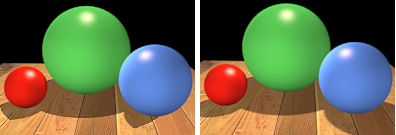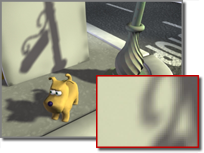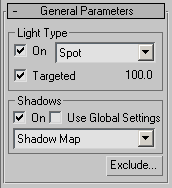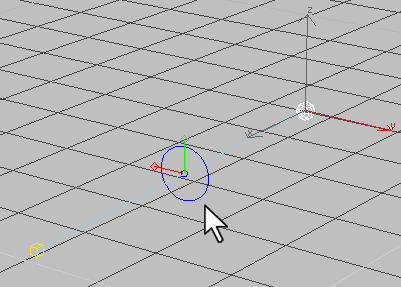This General Parameters rollout is displayed for standard lights. These controls turn a light on and off, and exclude or include objects in the scene.
On the Modify panel, the General Parameters rollout also lets you control the light’s target object and change the light from one type to another.
The General Parameters rollout also lets you turn shadow-casting on or off for the light, and choose which type of shadow the light uses.
Procedures
To turn a light on and off:
- Turn the On toggle on or off.
Default=on.
Tip: To make a standard light flash on and off, set its Multiplier parameter to 0 in repeated keyframes, and assign a step tangent to this parameter.
To have a light cast shadows:
-
In the General Parameters rollout
 Shadows group, make sure On is selected.
Shadows group, make sure On is selected.
The light will now cast shadows when you render the scene.

Left: A spotlight's projection cone truncates shadows.
Right: An omni light casts complete shadows.
To have a light use the global settings for shadows:
- On the General Parameters rollout, turn on Use Global Settings.
When Use Global Settings is on, the other shadow controls are set to the values used by all other shadow-casting lights in the scene that have Use Global Settings set.
Changing the affected parameters for one light with Use Global Settings set, changes them for all lights with Use Global Settings set.
To set a light's shadow parameters individually:
- On the General Parameters rollout, turn off Use Global Settings.
The settings revert to the individual settings for the light.
By default, Shadow Map is the active shadow type. In the Shadow Map Parameters rollout, the default settings are: Map Bias=1; Size=512; Sample Range=4.0; Absolute Map Bias=Off.

Scene with shadow-mapped shadows
Shadows rendered using default parameter settings
To cast area shadows:
- On the General Parameters rollout, choose Area Shadows from the drop-down list.
Use controls on the Area Shadows rollout to adjust the shadow properties.
To cast advanced ray-traced shadows:
- On the General Parameters rollout, choose Advanced Ray-traced Shadows from the drop-down list.
Use controls on the Advanced Ray-Traced Parameters rollout to adjust the shadow properties.
Advanced ray-traced shadows are similar to ray-traced shadows, however they provide control over antialiasing, letting you fine-tune how shadows are generated.
To cast shadow-mapped shadows:
- On the General Parameters rollout, choose Shadow Maps from the drop-down list.
- Go to the Shadow Map Parameters rollout.
- Use the Size spinner to set the size of the shadow map.
- Use the Bias spinner to adjust the shadow offset, if necessary.
- Use the Sample Range spinner to create a soft-edged shadow.
To cast ray-traced shadows:
- On the General Parameters rollout, choose Ray-Traced Shadows from the drop-down list.
- Use controls on the Ray-Traced Shadow Parameters rollout to adjust the shadow offset, if necessary.
Ray-traced shadows are generated by tracing the path of rays sampled from a light source. Ray-traced shadows are more accurate than shadow-mapped shadows.
To keep an object from casting shadows:
- Select the object.
- Right-click the object to display the quad menu, then from the Transform (lower-right) quadrant, choose Properties.
3ds Max opens the Object Properties dialog.
- Turn off Cast Shadows, and then click OK.
Now when you render the scene, the object casts no shadows.
To make an object not receive shadows:
- Select the object.
- Right-click the object to display the quad menu, then from the Transform (lower-right) quadrant, choose Properties.
3ds Max opens the Object Properties dialog.
- Turn off Receive Shadows, and then click OK.
Now when you render the scene, the object receives no shadows.
Note: You can also prevent objects from casting shadows by excluding them from a light.
Interface

Light Type group (Modify panel)
- On
- (Both Create panel and Modify panel) Turns the light on and off. When On is on, shading and rendering use the light to illuminate the scene. When On is off, the light is not used in shading or rendering. Default=on.
In viewports, the interactive renderer shows the effect of turning lights on or off.
- [light type drop-down list]
- Changes the type of the light. If you have selected a standard light type, the light can be changed to an omni, spot, or directional light. If you have selected a photometric light type, you can change the light to a point, linear, or area light.
This parameter is available only on the Modify panel.
- Targeted
- When on, the light is targeted. The distance between the light and its target is displayed to the right of the checkbox. For a free light, you can set this value. For target lights, you can change it by turning off the checkbox, or by moving the light or the light's target object.
Shadows group
- On
- Determines whether the current light casts shadows or not. Default=on.
- Use Global Settings
- Turn on to use global settings for shadows cast by this light. Turn off to enable individual control of the shadows. If you choose not to use the global settings, you must choose which method the renderer will use to generate shadows for this particular light.
When Use Global Settings is on, the shadow parameters switch over to show you what the global settings are. This data is shared by every other light of this class. When Use Global Settings is off, the shadow parameters are specific to that particular light.
- [shadow method drop-down list]
- Determines whether the renderer uses shadow maps, ray-traced shadows, advanced ray-traced shadows, or area shadows, to generate shadows for this light.
Each shadow type has its particular controls:
- Advanced ray-traced shadows
- Area shadows
- Ray-traced shadows
- Shadow maps
Tip: Use ray-traced or advanced ray-traced shadows when you want shadows cast by opacity-mapped objects. Shadow-mapped shadows don't recognize the transparent portions of the mapping, and as a result they don't look convincing.
- Exclude button
- Excludes selected objects from the effects of the light. Click this button to display the Exclude/Include dialog.
Excluded objects still appear lit in shaded viewports. Exclusion takes effect only when you render the scene.
Roll Angle Manipulator
To change the roll angle of a target light, you can use a manipulator. This can be useful if the light does not cast a round beam, or if it is a projector light (see Advanced Effects Rollout). To display the manipulator, select the light, right-click it, and then click Roll Angle Manipulator Toggle on the Tools 2 (lower left) quadrant of the quad menu.

Roll angle manipulator on a target light
Drag the circular portion of the manipulator to rotate the light by an arbitrary number of degrees. Click one of the red or green “clock hands” of the manipulator to rotate the light in 90-degree increments.